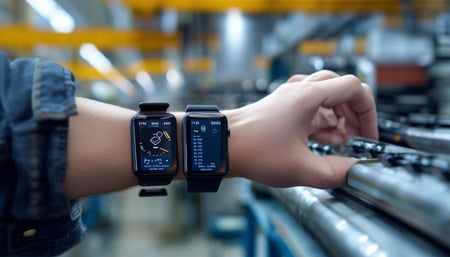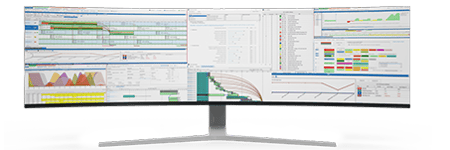Leveraging Wearables and Edge Technology in Industrial Manufacturing
Optimizing productivity, ensuring worker safety, and maintaining equipment efficiency are critical priorities in industrial manufacturing. Technologies such as wearables and edge computing have emerged as transformative solutions that offer a real-time flow of data, which can drive better decision-making and operational efficiency.
For a Manufacturing IT Manager, the potential to seamlessly integrate these tools with advanced planning and scheduling software like PlanetTogether and ERP systems (such as SAP, Oracle, Microsoft, Kinaxis, and Aveva) provides a powerful foundation for streamlined production and predictive insights.
This blog explores the potential of wearables and edge technology in industrial manufacturing, focusing on the integration of PlanetTogether and ERP platforms to harness the full value of real-time data.
We’ll cover how these technologies impact production planning, equipment monitoring, workforce management, and compliance while diving into practical integration approaches for a cohesive, agile production environment.

Wearables in Industrial Manufacturing
Wearable devices—ranging from smart glasses and watches to sensors and ruggedized tablets—have become valuable tools on the shop floor. These devices empower workers with real-time data and alerts, while providing supervisors and managers with a direct line of sight into employee productivity, safety, and task progression.
Some key applications of wearables in industrial manufacturing include:
Workforce Safety: Wearables equipped with biometric sensors can monitor vital signs, fatigue levels, and location, triggering alerts if an employee shows signs of distress or enters a restricted area.
Task Guidance and Training: Augmented reality (AR)-enabled glasses can overlay instructions and safety guidelines, guiding workers through complex tasks while reducing the risk of human error.
Equipment and Asset Monitoring: Sensors worn by operators can communicate with machinery to detect malfunctions, alerting the team to address maintenance issues before they escalate.
In tandem with edge computing, these wearables become even more effective. Edge devices stationed close to wearables can process data on-site, reducing latency and ensuring rapid responses.

Edge Computing: Processing Data at the Source
Edge computing involves deploying servers and computing resources close to the source of data generation. In manufacturing, this can mean placing processing power near equipment, sensors, and wearable devices on the shop floor, enabling faster data processing and real-time decision-making.
Edge computing offers numerous benefits:
Reduced Latency: Processing data at the edge means information is analyzed in real-time, which is essential for quick responses to critical events (such as equipment malfunctions).
Enhanced Security: Edge computing keeps sensitive data localized, reducing the risk of data breaches associated with cloud-based storage.
Efficient Bandwidth Usage: Only relevant insights are transmitted to the cloud or ERP system, decreasing the load on network bandwidth.
When integrated with wearables, edge technology ensures that production insights, workforce alerts, and machinery updates are not only timely but also accurately filtered for effective action.
![]()

Integrating PlanetTogether and ERP Systems with Edge and Wearables
Integrating wearables and edge computing with PlanetTogether’s advanced planning and scheduling software and leading ERP systems like SAP, Oracle, Microsoft, Kinaxis, or Aveva can transform manufacturing operations. With real-time visibility into production schedules and equipment status, these systems can enhance overall efficiency, streamline decision-making, and improve worker safety and productivity. Here’s how:
Enhanced Production Planning and Scheduling
With data flowing from wearables and edge devices directly into PlanetTogether’s scheduling system, manufacturers gain real-time insights into workforce availability, equipment status, and production bottlenecks. The integration of ERP systems further enriches this data, providing a holistic view of resources, demand forecasts, and inventory levels.
Example: A worker equipped with a wearable device enters the assembly area. The device’s location-tracking data is processed at the edge and sent to PlanetTogether, which checks for any conflicts or restrictions based on the current schedule. This integration with an ERP system, such as SAP, could adjust task assignments dynamically, minimizing production delays and ensuring an optimal flow on the shop floor.
Proactive Maintenance and Downtime Reduction
Wearables and edge computing allow for real-time monitoring of equipment conditions and worker safety, enabling proactive maintenance. PlanetTogether and ERP systems like Aveva or Microsoft Dynamics can leverage this data to create predictive maintenance schedules, minimizing costly downtime.
Example: A vibration sensor on a piece of equipment indicates an unusual reading. The edge system processes this and transmits an alert to PlanetTogether, which adjusts the production schedule accordingly, rerouting work to other equipment. Integration with an ERP system such as Aveva’s predictive analytics module could trigger a maintenance work order, ensuring that equipment is serviced before it fails.
Worker Safety and Compliance Monitoring
Wearables help monitor worker health and safety, especially in hazardous environments. Integrated with PlanetTogether and an ERP like Oracle or Kinaxis, data from wearables can be used to track compliance with safety protocols, issue alerts, and document safety incidents.
Example: If a worker enters a restricted area without authorization, the wearable device sends a signal to the edge computing platform. This data is then sent to PlanetTogether and Oracle, adjusting the production workflow to halt operations in that area, preventing potential hazards and ensuring compliance with safety regulations.
Data-Driven Decision-Making with Real-Time Analytics
Combining edge and wearable data with PlanetTogether’s analytics capabilities and ERP systems enables informed decision-making. Real-time insights into worker performance, equipment status, and production schedules can be visualized in dashboards for immediate action.
Example: A Manufacturing IT Manager can access a centralized dashboard showing data from wearables (like worker health metrics), edge devices (like equipment status), and integrated ERP data (like inventory levels). With PlanetTogether’s scheduling engine, they can see how to best allocate resources to meet demand while reducing labor strain and preventing equipment overload.

Practical Steps for Integrating Wearables, Edge Tech, and ERP Systems
Successfully integrating wearables and edge technology with PlanetTogether and ERP systems requires a well-defined strategy and collaboration across departments. Here are practical steps for achieving seamless integration:
Assess Infrastructure: Evaluate current networking capabilities, edge computing hardware, and wearable devices. Ensure the infrastructure can support real-time data processing and communication with PlanetTogether and ERP platforms.
Data Standardization: Data from wearables and edge devices must be standardized to integrate seamlessly with PlanetTogether and ERP systems. Work with your IT team to define data formats, labeling, and transmission protocols.
Data Privacy and Compliance: Wearables and edge computing introduce new privacy and security concerns. Implement strict data access protocols and ensure compliance with relevant data protection regulations.
Collaboration with Vendors: Engage PlanetTogether and your ERP vendor (SAP, Oracle, Microsoft, Kinaxis, or Aveva) to understand integration capabilities and create a roadmap for data synchronization, API connections, and training.
Pilot Testing and Scalability: Conduct pilot tests in specific areas of the shop floor to identify challenges and assess the effectiveness of wearables and edge integration with scheduling and ERP systems. Plan for scaling based on pilot outcomes.
For Manufacturing IT Managers in industrial manufacturing, the integration of wearables and edge technology with PlanetTogether and ERP systems like SAP, Oracle, Microsoft, Kinaxis, or Aveva offers a powerful opportunity to improve efficiency, enhance safety, and optimize equipment maintenance. With real-time data flowing seamlessly from the shop floor to planning and analytics platforms, manufacturing facilities can operate with heightened agility, meeting the demands of today’s fast-paced market.
By embracing these technologies and implementing a thoughtful integration strategy, industrial manufacturers can position themselves for a future where data-driven decision-making and real-time optimization are the new standards for success.
Are you ready to take your manufacturing operations to the next level? Contact us today to learn more about how PlanetTogether can help you achieve your goals and drive success in your industry.
Topics: Industrial Manufacturing, PlanetTogether Software, Enhanced Production Planning and Scheduling, Integrating PlanetTogether, Data-Driven Decision-Making, Proactive Maintenance and Downtime Reduction, Real-Time Analytics, Worker Safety and Compliance Monitoring




















LEAVE A COMMENT